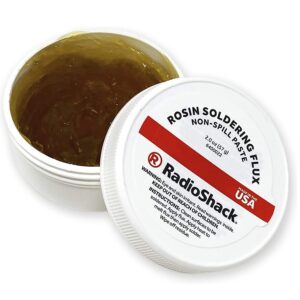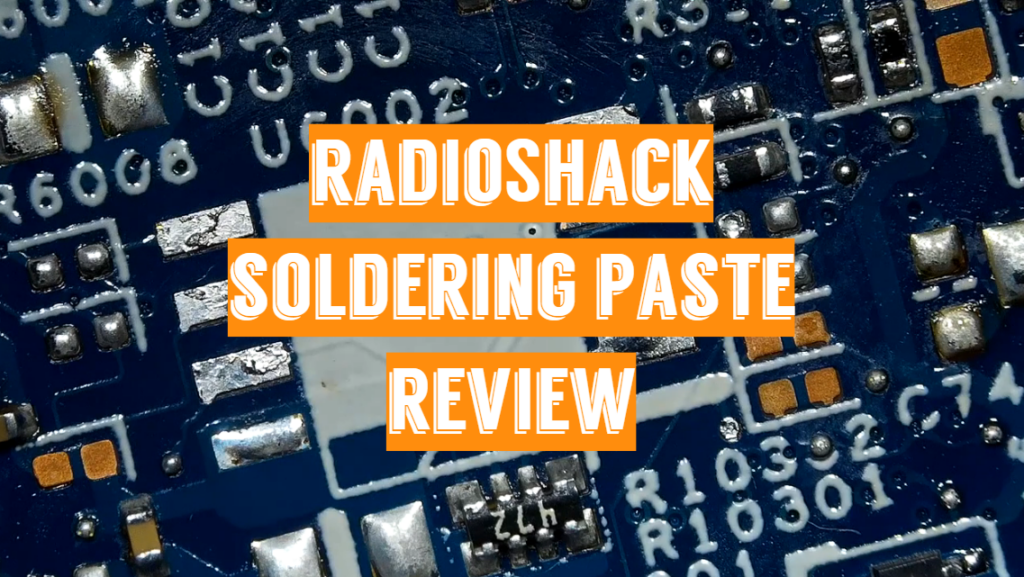For electrical soldering uses, this top-notch soldering flux may be of great assistance. That’s because petroleum jelly paste has more softened the RadioShack Rosin, which eliminates more oxides and impurities than normal rosin fluxes from a metal surface. Often, cleaning with a rag will quickly clean the remaining rosin, or you can apply a flux remover to cleanse the surface.

- Non-Spill
- 2 oz. Jar
- Made in USA
Another attribute that sticks out is its non-spill design, i.e., the rosin is dense enough to remain in position and not disperse to other regions.
Performance
A few examples of how you can use the RadioShack soldering paste:
- Electronic and electrical repairs;
- For vehicle wiring;
- For tinning wires;
- Light and average projects;
Possible issues and limitations:
- Can expose to the chemical residue including lead;
- Hard to wash off the hands;
- Always wash hands with soap after using;
- Never breathe its fumes. They may cause headaches, dizziness, allergic reactions or irritation;
- Never apply for repairs of portable water service systems;
- Never dispose of it along with household leftovers and garbage;
- Do not spill this product into the house sewage system;
Recommendations for users
Mixed with petroleum jelly paste, this electronic-grade rosin soldering flux is suitable for electrical and electronic soldering applications. It can be removed by rubbing with a rag or by solvent washing.
How to use this paste:
- Clean surfaces for soldering;
- Remove some gravel, paint, corrosion or padding by scratching, filing or sanding with a wire tool. For surfaces to be welded, add a minimal volume of flux;
- Heat elements, melting flux, and solder before the solder is ready to flow;
- Leave it to cool down and wipe clean;
Pros and Cons of RadioShack Soldering Paste
Pros
- Spill-free formula;
- Made in the United States;
- Helps solder flow smoothly;
- Doesn’t include ammonium chloride or zinc chloride;
- Easy to clean;
- Helps to produce strong joints;
- The best flux for electrical and electronics repairs;
- For strong solder joints;
- Easy to clean if needed.
Cons
- A bit sticky;
- The tube is not fully filled;
- Leakage is possible;
- A bit thick;
- Only 90 days of warranty;
- Very strange texture.
It is a must-have and fits with every soldering activity quite well. The Soldering Flux from RadioShack is very easy-to-use and reliable.
The Buyer’s Guide
Rosin flux is used to protect the soldered metal from oxidizing when heated by this RadioShack product, which would otherwise prevent the solder from attaching to the metal. The flux is liberally added to the cleaned (usually copper) metal to be soldered and the metal is heated with a soldering iron until the metal is hot enough to directly melt the solder.
When picking a welding paste, a few items to remember are:
Lead vs. lead-free components
The melting temperature is the main physical differentiation between lead and lead-free soldering paste. There is a higher melting point of the lead-free soldering paste, but it is a little difficult to deal with.
The most significant element in choosing between lead and lead-free soldering paste when it comes to deciding whether to choose is the target consumer. As mentioned in our recent RoHS-focused article, ignoring RoHS directives may potentially be expensive. It is in the best interest to be RoHS compatible and stop lead-based soldering pastes whether you are making a commodity that would be sold to customers and/or to a foreign market. While they are usually more costly, in the long term, it is an opportunity that will save you more.
No-clean vs water-soluble
Water-soluble fluxes include molecules of large molecular weight, such as polymers, that are not as efficient at stopping re-oxidation as rosins/resins. Water-soluble pastes offer boards a cleaner look after the board goes through the reflow point, burning off the flux residue and washing it off quickly in a board washer. If you chose not to rinse, the role of the flux is the same as the paste for cleaning water, except the stain stays on the board. In general, rosin/resin-based compounds are non-clean chemicals.
Rosins/resins render outstanding oxide barriers and shield the “cleaned” surfaces from re-oxidation during reflow. Experts have conflicting views on the effects of the residual residue, in contrast to drawing attention away from the aesthetics. Some assert that the residual of the remaining flux becomes inert, but others argue that later in the lifecycle it may have a detrimental effect on the substance.
The proper alloy ratio
There are 4 major factors when picking a solder alloy: lead material, melting temperature, the particle size of the alloy powder, and tensile strength.
The alloy ratio is the manufacturing engineer’s best option since they are the specialists in the reflow ovens as well as the alloy ratios that fit best with the component. This decision will, however, impact your costs. To be more knowledgeable about the selection process, you may take measures via:
For the assembly, deciding what strength and other necessary properties would fit better.
Knowing the preferred welding and the operating temperatures needed for your piece.
Having to recognize which components are being soldered and which are the most compatible materials.
Considering the malleability of multiple metals and alloys. Will it work under high temperatures, shaking, or friction, for instance, to understand the working condition for assembly?
FAQ
Is rosin paste the same as flux?
Generally speaking, a widely utilized flux is rosin. In its solid state rosin is inert and is present in the liquid phase only. Rosin flux includes 3 types for varying product needs: liquid, paste and solid. Strong flux is ideal for soldering iron, and wave soldering, liquid and paste fluxes are appropriate.
How to use the soldering paste without flux?
A white vinegar solution and salt may be found in a pinch. This generates moderate acid. Even a tarnished penny will glitter before your eyes. This can act like a kind of flux that helps you to solder the copper or aluminum pieces you want to solder for an electrical link.
As for flux, the rosin works (a component that prevents oxidation and helps with bonding). Flux is important, but the project would be ruined by the wrong kind of flux. With the soldering gun, acid core solder can be combined and used only for plumbing and home repairs.
What can you use instead of flux when using this paste?
The better solution to flux is petroleum jelly because it’s inexpensive, reliable, it’s on hand for most people, and it can act as a cleaner. Lemon extract, homemade pine tar flux, and homemade rosin flux are other pleasant substitutes.
Is the RadioShack soldering paste toxic?
Soldering with lead (or other metals) may create dangerous dust and fumes. In addition, the usage of rosin-containing flux creates solder gases that may result in workplace asthma or exacerbate established asthmatic symptoms if inhaled, as well as induce inflammation of the eye and upper respiratory tract.
Video Review: How to Use Solder Paste
Final thoughts
This RadioShack rosin soldering flux is a good high alternative for buyers as RadioShack is very common and trustworthy. This one is also made in the USA, just like several other choices. You can find 2 ounces of soldering flux in each package when you get to the pack size. Unlike several other choices for soldering flux, this one uses a non-spill formula that means that when operating on electrical circuits, the flux does not get anywhere.




Hi, I want to share some experiences with you. Flux (soldering paste) is a material that helps the solder melt and flow, which helps maintain a soldering joint. Flux can be made from organic or inorganic materials such as rosin (a vegetable oil resin), zinc chloride (a salt), copper chloride (a salt) borax (sodium borate, a mineral).
Petroleum jelly is an alternative to solder paste. It is anti-corrosive and will not damage your material. Now I test it in my new projects!
Hi, Kevin! Tnanks for sharing.